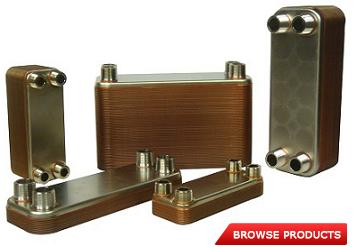Benefits Of Using A Flat Plate Heat Exchanger
Heat exchangers have now become an inseparable part of every modern home. They are used for radiant, domestic water heating and even for heating swimming pools and spas. However, heat exchangers, especially flat plate heat exchangers have become extremely popular owing to their compact structure and higher heat transfer rates.
 Flat plate heat exchangers were first introduced in 1920s and since then have replaced traditionally used heat exchangers like shell and tube heat exchangers in almost every industry as well as household applications. Unlike traditional, they do not consist of pipes but metal plates, usually made from stainless steel. Stainless steel is the metal of choice for constructing flat plate heat exchangers because it can bear high temperatures, does not corrode easily and is extremely strong as well as highly malleable.
Flat plate heat exchangers were first introduced in 1920s and since then have replaced traditionally used heat exchangers like shell and tube heat exchangers in almost every industry as well as household applications. Unlike traditional, they do not consist of pipes but metal plates, usually made from stainless steel. Stainless steel is the metal of choice for constructing flat plate heat exchangers because it can bear high temperatures, does not corrode easily and is extremely strong as well as highly malleable.
Flat plate heat exchanger consists of a series of metal plates, which are either welded together or brazed together or separated by gaskets. These plates are then compacted by placing them in a rigid frame in such a manner that the hot and cold fluids flow in alternate channels. Brazed plate heat exchanger plates are brazed together in a vacuum furnace to reduce leaks.
Get the benefits of using a flat plate heat exchanger. Our high efficiency flat plate heat exchangers
Get the benefits of using a flat plate heat exchanger. Our high efficiency flat plate heat exchangers are extremely popular due to their compact structure and higher heat transfer rates.
The main advantages of using flat plate heat exchangers are given below:
1. Compactness – Flat plate heat exchangers use far less space than most of the conventionally used heat exchangers, especially tube and shell heat exchangers. They need much less space than traditional heat exchangers to transfer the same amount of heat.
2. High Efficiency – The main difference is that liquids actually make contact with the heat conductor inside the flat plate heat exchanger unlike with shell and tube design where liquids can only make contact with the outer shell. This results in better heat transfer capacity and lower energy usage.
3. Flexibility – Flat Plate Heat Exchangers can be used in a variety of applications and can easily work with several types of fluids. Apart from that, several standardized models are available in the market, which eliminates the need for custom designed heat exchangers.
4. Lower Cost – The factors that drive down the cost of a compact heat exchanger like flat plate type are its size and the method of fabrication of plates. Flat plate heat exchangers are extremely compact since they are made of small plates and not long pipes, as is the case with tube and shell heat exchanger. In addition, since the plates are usually brazed and not welded, the cost of manufacturing is significantly lower.
5. Easy Maintenance – Flat plate heat exchangers can be easily cleaned in most of the cases by back flushing warm water or a dilute cleansing solution. Additionally, fluid turbulence has a natural self-cleaning effect that reduces damage due to built-up.
6. Better Temperature Control – One of the biggest advantages and the primary reason for popularity of flat plate heat exchangers is its ability to work at temperature difference of as low as 1 deg F (C). Most conventional heat exchangers see a significant drop in efficiency when the temperature difference between the two interacting fluids drops below 5 deg F (C).





